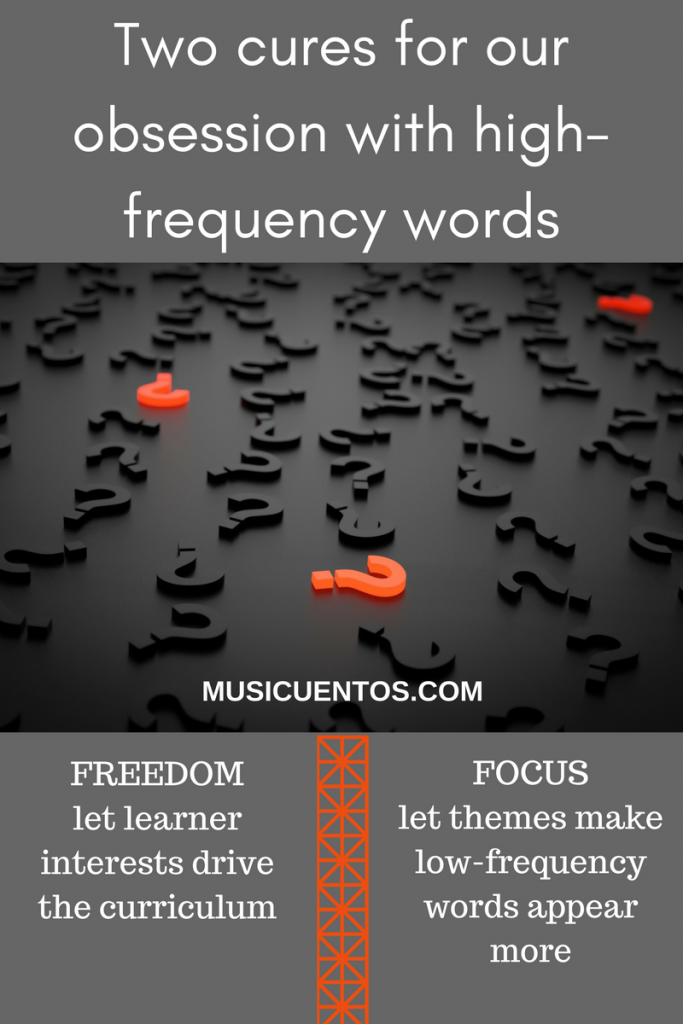Since I developed a student handout with the highest-frequency Spanish words organized by type and including translation and rank, and recently posted about how we put our most helpful high-frequency words and phrases on our shower-curtain word walls, it stands to reason that I’m a big fan of high-frequency words.
Well, I am and I’m not.
The problem is what I can and cannot do with high-frequency words. Using, for example, the 500 most frequently used words in the Spanish language, what can I do? Well, I can… use a question word (note I did not say “ask a question”). I can connect. I can magnify and minimize. I can throw in some verbs.
But as I work (slowly) on my Russian, what has struck me is what I cannot do. I cannot talk about anything. I can’t describe. I can say that I want, but I cannot say what I want. I can say that I have, but I cannot say what I have. In the end, I cannot carry on the most basic of conversations. Very high-frequency words on their own are so useless it’s driven me (and in turn, my students) to the quest for more nouns. More adjectives, too.
Want some statistics to further see the futility of excessive focus on even the 500 most frequent words? Here are the numbers from the research:
- A five-year-old starting school has a vocabulary of four to five thousand word families.
- A conservative estimate is that you need a vocabulary of six thousand words to cover 90% of a text.
- Another analysis claims fifteen thousand words will cover 95% of a text.
- 80% coverage (conservatively, two thousand words) is not enough to give the context needed for guessing to allow comprehension of a text. This number needs to be 95%.
But how do we approach this desperate need learners have for reasonably low-frequency words to combine with their high-frequency structures in order to communicate anything real? Acquisition is what it is, and it requires repetition, and it requires time. How can infrequent words and structures come up enough? They do when you’re flooded with the vast amounts of input you get while growing up in your native language. Otherwise, they simply don’t.
Unless you have two things: freedom, and focus.

Set them free
Don’t formulate the language for them – ask the questions, and let them answer. I’ve heard some presenters use the statistic of where orange falls in the word frequency (it’s really low). On the one hand, it’s true that giving long lists of vocabulary is contrary to what we know about what learners can possibly handle and acquire at one time.
But the thing is, if your learner’s favorite color is orange, and half his clothes are orange, he needs the color now. We’re not doing them favors by throwing out the list of colors because they’re low on the frequency list. When we plan our lessons around what students want to talk about, what their lives are about, the vocabulary will come up again, and again, and again, which, you guessed it, causes solid language acquisition.
Put (the thing) in focus
I recently reviewed an elementary curriculum that used the term “thematic units” and then upon further investigation, the units ranged from “Around the house” to “Colors, numbers, and shapes.” “Around the house” is a thematic unit, in my opinion: it purports to frame any language use, from vocabulary to structure, as useful to talk about what happens around my house. “Colors, numbers, and shapes,” on the other hand, is simply a vocabulary list reference, not a unit at all, much less a thematic one.
When we teach with thematic units, we (should) end up making all the resources and all the activities have something to do with that theme. That means that the language needed will come up time and again. The thing is, you don’t have to go too far beyond the top 500 to get into repetitive words. Most of language is formed within the top several thousand words. Get on the target-language resources and you’ll end up with the repetition. Especially if you’re mixing learner resources with authentic ones. I love many learner novels, and I’ve used them to structure 4 of the last 5 semester units I’ve taught, but if we feed our learners a diet of 100% learner material, we’re cheating them. Most are carefully constructed to use only 100-300 “new” words, which is great for comprehensibility, not so much for the lower-frequency words kids will need. Unless, of course, it’s part of the theme. Mixing in some authentic resources will balance the mix. (As an example, this World Cup commercial was an at-home activity following Chapter 9 of Peter va a Colombia– and look, it uses the very high-frequency word for “I am,” as well as the word for “orange.”)
Want to see this in action? Check out how Carrie Toth tells her learners to Be the Water and how Kara Jacobs frames up the bullfighting culture in her class.
You can even use the same resource several times. In my Russian journey, I do this with songs, but I’m motivated so I don’t need to change up the activity; I really can’t get enough of the same song. However, teachers often successfully change activities on the same resource (see: “How I use Textivate” from @welangley) or the concept of embedded reading or my own embedded listening.
Want to check out another strategy to help learners combat the maddening lack of vocabulary to say what they want to? Check out my post(s) on the most important tool: circumlocution.
Any other tips on helping learners acquire language that they need but is not so high-frequency?
3 Comments
Comments are closed.



[…] talks about our obsession with high-frequency words and how to cure […]
[…] An interesting discussion at http://musicuentos.com/2018/04/frequency/ […]
[…] love for high-frequency vocabulary is natural, but in this post, I propose that there’s very little we can do with only the highest-frequency words. In […]